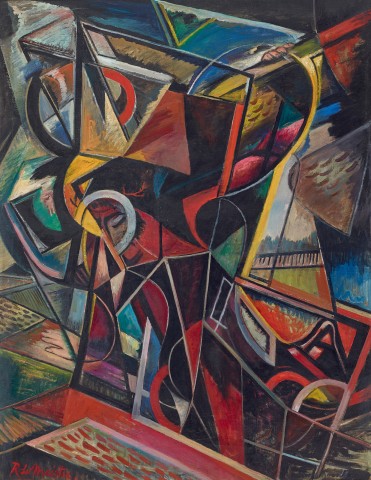CHRIST FALLS FOR THE FIRST TIME, c.1948 – 49
ROY DE MAISTRE
oil on canvas
109.0 x 84.0 cm
signed and dated lower left: R de Maistre.
inscribed verso: LEROY de MAISTRE / 13 ECCLESTON ST. / LONDON S.W.I / ENGLAND
label attached to stretcher verso: James Bourlet & Sons, Ltd London
copy of original purchase receipt attached verso
Michael Ailion, United States of America, acquired directly from the artist in 1967
The Estate of Michael Ailion, United States of America
possibly: Roy de Maistre and Arthur Pollen, Ashely Gallery, London, 1950
possibly: Contemporary British Painting, Society of the Four Arts, Palm Beach, Florida, 6 – 29 January 1956
possibly: The 198th Summer Exhibition of the Royal Academy of Arts MCMLXVIII, Royal Academy of Arts, London, 7 May – 14 August 1966, cat. 699 (as ‘Christ falls under the Cross’, undated)
Christ Falls the First Time, c.1947, 41.4 x 31.1 cm, Pallant House Gallery, Chichester, United Kingdom
Third Cross of the Station, 1948, 78.0 x 60.0 cm, Arts Council Collection, London (on long term-loan to The University of York, England, until 2007)
Study for Stations of the Cross, First Fall, undated, oil on board, 78.7 x 61.0 cm, private collection, illus. in Johnson, H., Roy de Maistre: The Australian Years 1894-1930, Craftsman House, Sydney, 1988, pl. 51, p. 110
Religion played an important role in Roy de Maistre’s life from an early age. However, it was following his relocation to London in 1930 that he really started concentrating on the subject artistically to the extent that by the 1950s, he was recognised more for his religious paintings than for any others. The technical success of these works varies greatly but Christ Falls for the First Time, c.1948 – 49, is most surely one of the masterworks among them. It features his decorative, highly personalised form of Cubism through which he evokes an emotional impact that is hard to ignore.
De Maistre was born into a family of practicing Anglicans and, like many of his generation, was deeply affected by the atrocities of World War One, developing a keen interest in spiritualism. In discussing his work during the 1920s, he would occasionally invoke biblical references, paraphrasing, for example, 2 Corinthians 4:18 with the observation that ‘the things seen which are temporal (reveal) the things seen which are eternal’.1 In middle age, he became increasingly drawn to Catholicism with its ‘grandeur of a solemn religious ceremony’, believing that ‘religion isn’t primarily concerned with understanding but with a kind of total appreciation that … deeply involves one’s aesthetic sensibilities’.2 A key aspect of this quest was that de Maistre sought to express the individual spirit inherent in his subjects be they portraits, landscapes or in this case, biblical subjects. Early works in this vein include a ‘naturalistic’ image of the Archangel Gabriel handing Mary white lilies, set against a background of St Jean De Luz, France (Angel of Peace, c.1930 – 31, formerly John Fairfax Collection); and the first of his abstracted renditions on the Passion of Christ, Crucifixion, 1932 – 45 (Art Gallery of New South Wales, Sydney). De Maistre often discussed the work of Picasso with his protégé Francis Bacon, but his own distinctive technique follows the cooler, more formalist approach of Juan Gris and Jean Metzinger. In Christ Falls for the First Time, the subject is almost buried within a tumult of shapes, facets and texture. The design is anchored by a blocky ‘z-shape’ at its centre that is, in turn, pierced by the diagonal of the cross bar which the fallen figure grasps with one hand as he balances with the other. To the right is the suggestion of a feathered wing, whose brushed markings are picked up elsewhere, a visual staccato running through the rest of the composition. A series of half-circles acts as a counterpoint to the otherwise sharp lines, all of which contain a full spectrum of colour.
De Maistre enjoyed working in series doing multiple versions of individual images as he explored different compositional strategies, with the largest example being the most resolved. The Arts Council of Britain owns a smaller, less developed version of this lot, titled Third Station of the Cross, First Fall, 1948; and at his Retrospective in 1960 at the Whitechapel Gallery, London, de Maistre exhibited four works with this title (all dated 1947) which he descibed in the catalogue as being ‘stages of development of work in progress’.3 In 1954, de Maistre was given the important commission to paint fourteen Stations of the Cross for the (non-public) Long Corridor of Westminster Abbey. Given the almost literal depiction of the Stations evident in the few published reproductions from this little-seen sequence, Christ Falls for the First Time, is instead a significant example of the artist’s more idiosyncratic and personal response to the subject.
1. Roy de Mestre, ‘Modern Art and the Australian Outlook’, Art in Australia, 3rd series, no. 14, December 1925
2. David Konstant, Bishop of Leeds, 1988. Cited in Johnson, H, ‘The Modernist Religious Painting of Roy de Maistre 1930-1960’, in Michael Griffith, James Tulip (eds). Religion, Literature and the Arts Project: Conference Proceedings of the Australian International Conference 1995, Australian Catholic University, Sydney, 1995, p. 203. De Maistre was baptised into the Catholic faith in 1947, then confirmed in 1951.
3. Roy de Maistre: A Retrospective Exhibition of Paintings and Drawings 1917-1960, Whitechapel Art Gallery, London, May – June 1960, cats. 75 – 78, as ‘Christ falls for the first time.’ Each was 78.5 x 61 cm.
ANDREW GAYNOR
